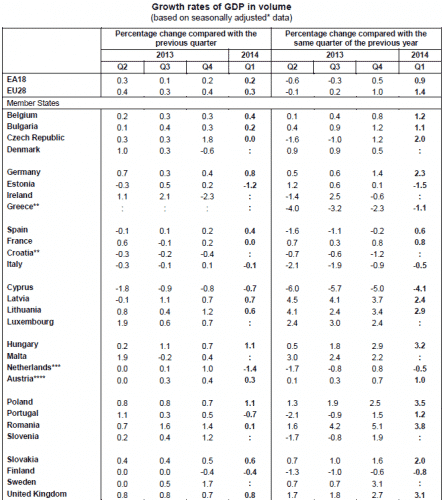ECB gets green light on stimulus as half of eurozone contracts
The data out of the eurozone this morning were below expectations. Growth in Q1 was up just 0.2% versus an anticipated 0.4% pickup. Much of this growth came from Germany, as many countries in the eurozone saw no growth or contraction. This is the final piece of data that will give the ECB a license to ease – and ease aggressively.
Yesterday, I outlined the ECB’s options, noting that in Q1 “the industrial production number is another figure showing sluggish growth at best.” The point here was that growth’s undershooting means inflation undershooting as well. And with the eurozone still at stall speed, any exogenous shock could tip the eurozone back into recession. And in that case outright deflation, and a resumption of debt deflation would be all but inevitable. The ECB recognizes this and has prepared a plan of attack.
Now, stepping back for a moment, let’s remember that the eurozone is caught up in the tighter fiscal, looser monetary policy paradigm that we see in every major developed economic region including Japan. It is monetary policy doing the heavy lifting over fiscal in the US, Canada, Australia, Japan and the UK. In Europe, where back-loaded austerity is still the prevailing policy paradigm in the periphery, that means continued sluggish demand, internal devaluation and deflation. The only chance Europe has of offsetting this is via a basing effect in the periphery due to a bump in growth from a low base, growth in the core, especially in Germany, and easy monetary policy.
The figures we saw this morning indicate that while growth in Germany remains robust, the basing effect is not robust, and growth elsewhere in the core has broken down. That puts an extra strain on monetary policy. And I believe the ECB will be more aggressive as a result.
In terms of the expanded periphery, the Greek economy shrank by 1.1% in unadjusted terms in Q1 on an annualized basis, according to Greece’s statistics agency. I did not see data on the seasonally-adjusted basis that Eurostat uses. But let’s remember that the Greek economy shrank 3.86% in 2013 and was still shrinking in Q1. Moreover, if you look at the 14.5% year-on-year decline in office rents in Q1, that tells you that business is so slack in Greece that internal devaluation and deflation are very much the driving force in the Greek economy. The anticipated basing effect to pull Greece out of depression is not evident in any of these numbers.
Elsewhere, Spain was a good performer with a 0.4% increase in seasonally-adjusted GDP growth. But Italy’s economy contracted 0.1%. Portugal’s economy contracted 0.7%. Cyprus contracted 0.7%. And France was stagnant. I have not seen Irish figures.
These are horrific numbers. And while they might be a one-quarter statistical quirk, the situation remains relatively bleak. Tepid growth is an upside scenario.
The core of the eurozone is not helping either. Yes, Germany was up 0.8%. ANd Belgium and Austria were doing well. But the Netherlands saw GDP plunge 1.1%, while Finland contracted 0.4%. The Finnish electorate, which is dealing with a housing bubble by the way, has turned against austerity. The pro-austerity Finance Minister was just ousted as her party’s leader for just this reason. We should expect continued weakness in both Finland and the Netherlands because of housing excesses.
Eurostat Figures are below.
The whole tenor here is dire enough that we should expect massive easing from the ECB. Since I wrote my post yesterday, I have seen multiple confirmations that the ECB will but rates 10-20 basis points from the present 0.25%. I have also seen confirmation that a tax on excess reserves and a new ECB lending facility are being contemplated. Nowhere is anyone talking about QE. And I have not heard anything about the periphery bond sterilization scheme I mentioned yesterday.
What we have to conclude then is that the ECB will ease in June on multiple fronts. We will see a rate cut. But likely we will also see both a tax on excess reserves and a new lending facility with a credit growth mandate attached. I don’t see a rate cut or a tax on excess reserves as having ay meaningful value in boosting growth. The lending facility may do, but it will be a while before the effects are felt in the economy.
Meanwhile, we should expect fiscal policy to remain focused on deficit reduction and austerity in the periphery. The result will be a eurozone economy that remains susceptible to exogenous shocks. We should therefore pay special attention to the sovereign bond convergence play. I believe convergence works only in a cyclical recovery. Renewed recession means yield divergence and crisis.

Comments are closed.